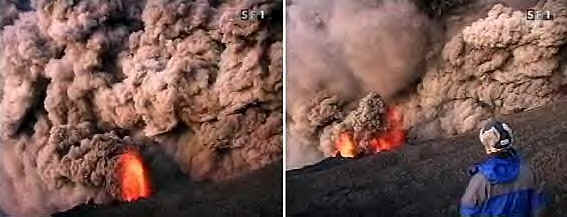

Etna Volcano in Sicily is back in the news again with a
major eruption that began in late October, 2002. Here are some images from Swiss Televison
from the Stromboli
Online website. A good account of the eruption in progress by Dr. Sonia Calvari follows:
On 26 October 2002, at 22:25 local time, a swarm of earthquakes was recorded
by the seismic network of the National Institute of Geophysics and
Volcanology Section of Catania. Until 1st November, about 500 shocks have
been recorded. After three hours from the beginning of the swarm, a new
flank eruption started at Mount Etna volcano. The seismic swarm anticipated
and accompanied the paroxysmal explosive activity in the summit area.
A survey performed at 4:00 am on 27th October showed two eruptive fissures
opened on the north and south flanks of the volcano. Fire fountain activity
was observed at both fissures, which were still propagating upslope and
downslope when observed. Lava flows soon started to pour out from the lower
part of the northern fissure, causing concern around Piano Provenzana, on
the north flank of the volcano. Two major flows started from the lower end
of the fissure, spreading NE and E. The NE flow stopped on 31 October after
having travelled 2 km, when a decline in the effusion rate was observed.
The E flow slowed down until 1st November, but is still moving and crusting
over in the middle portion of the flow field. A few sectors of solid crust
have been detected from a survey with the helicopter of the Civil Protection
using a thermal camera. This suggests that a lava tube is forming on this
lava flow. The ski station and tourist shops on Piano Provenzana have been
first destroyed by the earthquakes, then surrounded by lava flows. The flows
have also caused fire and destroyed parts of the pine forest. Since the E
flow is still slowly spreading towards Linguaglossa, our monitoring effort
is mainly concentrated in following its development. Flow mapping is limited
by fire developing around the flow fronts, and by the ash cloud covering
most of the flow field. The maps reported in our web site (www.ct.ingv.it)
were obtained primarily using a helicopter-borne FLIR TM 695 thermal camera.
The lava flow from the south fissure started some 12 hours after the north
one, spread SW and split in two branches around Monte Nero, following the
same path of one of the 2001 lava branches. The south flows stopped on 31st
October, reaching a total length of about 1 km. Fire fountains and
phreatomagmatic activity decreased in intensity with time at both the north
and south fissures.
The south fissure opened at 2700 m elevation, has a direction N20°W, and is
located a few hundred metres west of the 2001 south fissure field, between
Monte Frumento Supino and Cisternazza (see map at www.ct.ingv.it). Spatter
falling around the vents formed two cinder cones about 20-30 m high. Fire
fountain activity from these vents were initially 100 to 300 m high,
producing an ash plume and abundant ash fallout on the south flank of the
volcano. About 2.5 kilos of ash per square meter fell on Catania in three
days as a consequence of strong wind blowing southward, and this caused
disruption at the local airport. The north fissure opened between 2500 and
2350 m a.s.l., close to the 1809 fissure. It is a few km long and expanded
NE following the NE Rift Zone. The effusion rate from the north fissure is
actually declining, and this increases the possibility of lava tube
formation along the E flow.
Dr. Sonia Calvari
Istituto Nazionale di Geofisica e Vulcanologia
Sezione di Catania
Piazza Roma 2
95123 Catania
tel: +39 095 7165800 tel (direct): +39 095 7165800
e-mail: calvari@ct.ingv.it fax: +39
095 435801
http://www.ct.ingv.it
------------------------------------------------------------
Return to Archive or go to Next Photo.